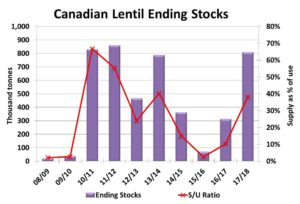In 2016, Canadian farmers responded to record high yellow pea prices by boosting acres and production to a new record, with the crop at least 1.4 million tonnes (44%) more than in 2015. In fact, there’s a good chance the final crop estimate will be even larger yet once the final tally is in.
In order to deal with this record crop, a big boost in exports is needed. So far in 2016/17, that’s been the case. As of shipping week 8, the CGC is showing 1.0 million tonnes have been exported through licensed channels, which don’t include container shipments. The chart shows that exports in the first three weeks of the marketing year were next to nothing, so this record pace is even more impressive. Nearly one-third of the year’s pea export forecast has moved in just five weeks.
This hectic pace won’t continue however. The chart shows that a large surge in exports is normal as new-crop supplies hit the market. Then the pace slows down. This year has been exceptional due to extremely tight global inventories that needed to be replenished. Some of these sales had already been made almost a year ago, when new-crop pea bids started showing up back in Oct/Nov of 2015. That means these strong exports don’t reflect fresh demand.
While these record exports are positive, direction in the pea market really depends on how buyers will behave for the rest of 2016/17. The heavy exports from Canada (and other countries) mean that demand for the first 4-5 months of the marketing year has been satisfied. At this point, overseas buyers are able to be more patient before adding sales for January and forward delivery. To some degree, this signals a shift from a sellers’ to a buyers’ market where their bids are now $20-30 per tonne below where sellers’ ideas are.
The main reason why overseas buyers can be more patient is that pea production hasn’t just responded in Canada, but in most other countries. Among the top five export competitors, only France has seen a drop in the 2016 crop, when poor weather more than offset an acreage increase. Among the countries shown in the chart, 2016 production increased by over 800,000 tonnes, and that’s on top of Canada’s 1.4 million tonne increase.

Of course, this is mostly looking at the supply side of the equation. As seen in the first chart, the two main global buyers – India and China – have already been buying heavily from Canada (and elsewhere) and the initial demand is satisfied. Chinese purchases tend to be relatively steady throughout the year and total volumes don’t show huge changes from year to year.
Most of the increase in demand would need to come from India and a few surrounding countries. Now that buyers there have already bought enough peas through the end of December, the export outlook largely relies on the outcome of India’s rabi pea and desi chickpea crops that will be harvested in Feb/Mar. Planting will begin shortly and soil moisture conditions are generally positive. High prices, especially for chickpeas, will help encourage more acres, although the government’s decision to raise the minimum support price won’t have much of an impact.
Overall, the exceptional demand early in 2016/17 will clean up a large part of bigger 2016 crops but the “make or break” outlook mostly depends on weather related issues on the other side of the world. That’s why it’s important to stay on top of weather developments, especially in India.